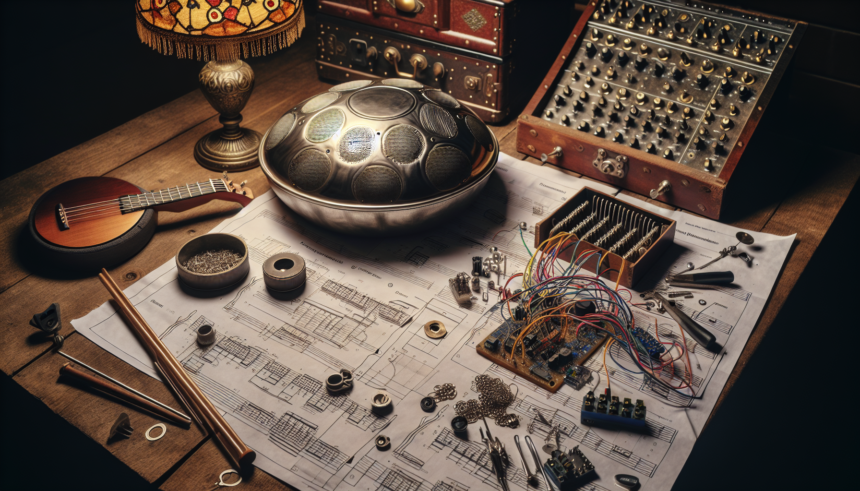Introduction
The handpan, with its ethereal and mesmerizing tones, has gained immense popularity among musicians and music enthusiasts. To enhance the sound and enrich the acoustic experience, an amplifier is often used. However, commercially available amplifiers can be expensive and may not always meet the unique requirements of handpan players. This is where DIY handpan amplifiers come into the picture. Building your own amplifier not only allows for customization but also provides a hands-on understanding of acoustic engineering. This article will guide you through the steps to create your own handpan amplifier, ensuring you achieve unparalleled sound quality.
Materials and Tools
Before you begin constructing your DIY handpan amplifier, gather the necessary materials and tools:
- Wood or acrylic sheets (for the amplifier body)
- Speakers (preferably full-range)
- Amplifier board or module
- Battery pack or power supply
- Wiring and connectors
- Soldering iron and solder
- Drill and screws
- Screwdriver
- Multimeter (for testing connections)
Step-by-Step Guide
Step 1: Design the Amplifier Body
The first step in building your DIY handpan amplifier is designing the body. The shape and size of the amplifier body will significantly influence the acoustics. Choose a sturdy material like wood or acrylic that can resonate well. Design a box or a shell that can house the speakers and the amplifier module conveniently. Consider adding ventilation holes to prevent overheating.
Step 2: Install the Speakers
Once the body design is finalized, it’s time to install the speakers. Full-range speakers are ideal for handpans as they can reproduce a wide range of frequencies. Position the speakers in such a way that it enhances the natural sound of the handpan. Secure the speakers firmly using screws, and ensure that the wiring is accessible for further connections.
Step 3: Connect the Amplifier Board
Next, you’ll need to connect the amplifier board or module. This component is crucial as it amplifies the signal from your handpan, making it louder and clearer. Follow the manufacturer’s instructions to connect the speakers to the amplifier board. Use a soldering iron to ensure secure connections and minimize sound distortion. Double-check all connections with a multimeter to ensure they are correct.
Step 4: Power Supply Setup
Decide on the power supply for your DIY amplifier. A battery pack is ideal for portability, while a stationary amplifier can use a power adapter. If using batteries, ensure they are securely mounted and connected with proper polarity. For a power adapter, make sure it meets the voltage and current requirements of the amplifier module.
Step 5: Test and Fine-Tune
Before sealing the amplifier unit, test the setup. Play your handpan and listen to the amplified sound. Check for any distortions or unwanted noise. Fine-tune the connections, speaker positioning, and amplifier settings to achieve the desired sound quality. Once satisfied, secure all components and close the amplifier body.
Advanced Customizations
For those looking to further enhance their DIY handpan amplifier, consider these advanced customizations:
- Equalizer: Install an equalizer to allow for fine control over different frequency bands, enabling you to shape the sound according to your preference.
- Effects Pedals: Adding effects pedals like reverb, delay, or chorus can significantly alter the sound, providing more versatility in your music.
- Bluetooth Connectivity: Integrate a Bluetooth receiver to allow wireless connection with other devices, making it easier to play along with backing tracks or recordings.
- Custom Enclosure Design: Personalize the amplifier body with artistic designs or finishes to match your style and make it a unique piece of musical equipment.
Benefits of DIY Handpan Amplifiers
Building your own handpan amplifier comes with several benefits:
- Cost-Effective: DIY amplifiers can be more affordable than commercial options, especially if you already have some of the necessary tools and materials.
- Customization: You can tailor every aspect of the amplifier to suit your specific needs and preferences, ensuring the best possible sound quality for your handpan.
- Learning Experience: The process of building an amplifier enhances your understanding of sound engineering and electronics, which can be applied to other DIY projects.
- Unique Sound: A custom-built amplifier can offer a unique sound signature that commercial products may not provide, allowing for a more personalized acoustic experience.
Conclusion
Creating your own DIY handpan amplifier can be a rewarding endeavor, providing you with both a superior acoustic experience and a deeper appreciation for the art of sound amplification. With the right materials, tools, and a bit of patience, you can build an amplifier that not only enhances your handpan’s sound but also reflects your personal touch. Remember to experiment with different designs and setups to find what works best for you. Happy building and playing!
FAQs
1. What are the key components of a handpan amplifier?
The key components of a handpan amplifier include the amplifier body (usually made of wood or acrylic), full-range speakers, an amplifier board or module, a power supply (battery pack or power adapter), wiring, and connectors. Additional components may include equalizers, effects pedals, and Bluetooth modules for advanced customizations.
2. Can I use any type of speakers for my handpan amplifier?
While you can use various types of speakers, full-range speakers are recommended because they can reproduce a wide range of frequencies, ensuring the full spectrum of the handpan’s sound is amplified. Smaller speakers may miss some of the lower frequencies, while larger woofers might not capture the higher tones effectively.
3. How can I prevent my DIY amplifier from overheating?
To prevent overheating, ensure proper ventilation by adding ventilation holes or slots in the amplifier body. You can also install small cooling fans if necessary. Avoid placing the amplifier in confined spaces and ensure it has adequate airflow during use.
4. Is soldering necessary when building a handpan amplifier?
Soldering is often necessary to ensure secure and reliable connections between components. Poor or loose connections can lead to sound distortion or complete signal loss. If you are not comfortable with soldering, consider using high-quality connectors that can provide secure connections without the need for soldering.
5. Can I add custom designs or artwork to my amplifier?
Absolutely! One of the joys of DIY projects is the ability to personalize your creations. You can paint, carve, or add decorative elements to the amplifier body to reflect your personal style. Just ensure any modifications do not interfere with the acoustics or functionality of the amplifier.





